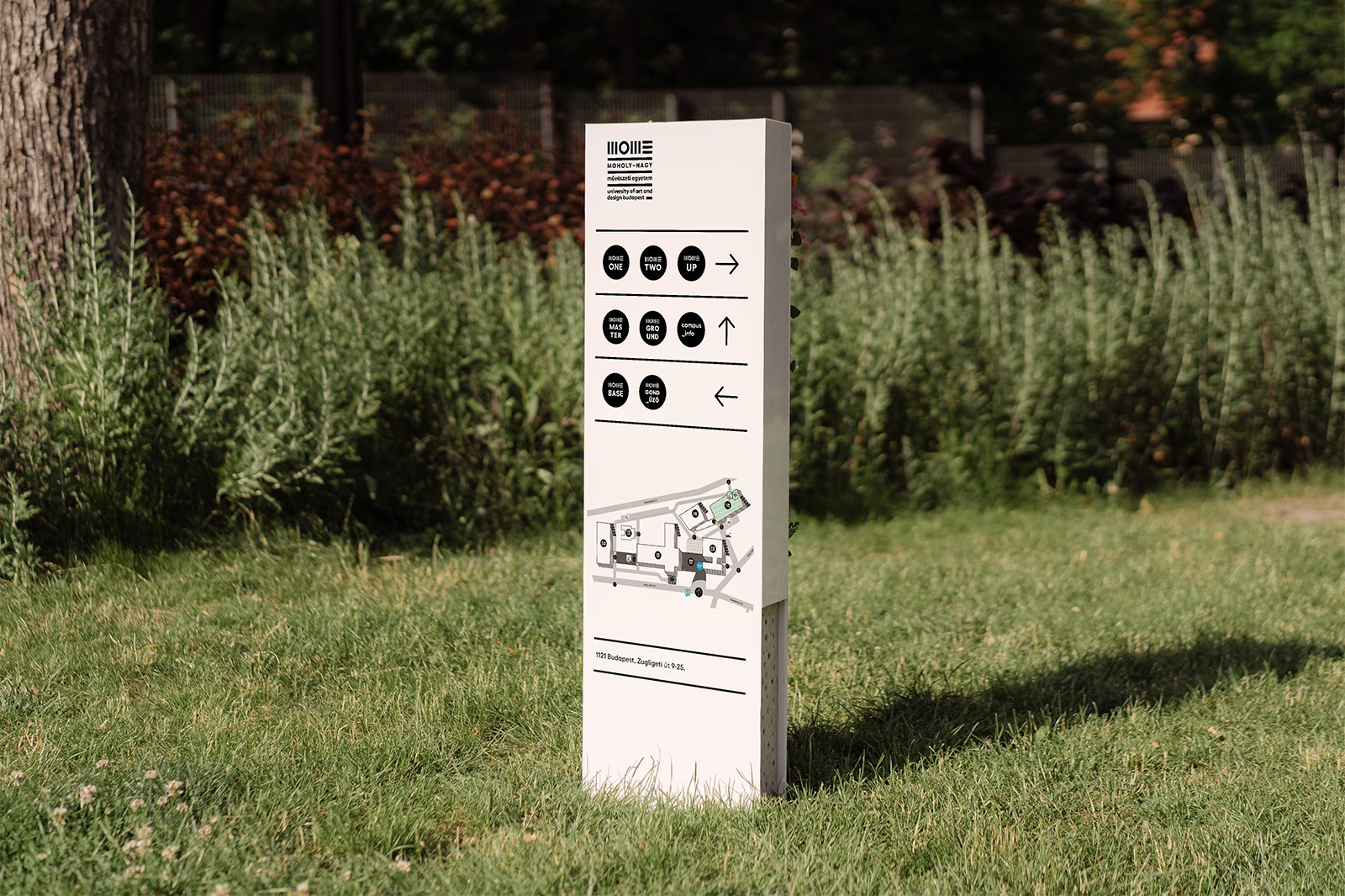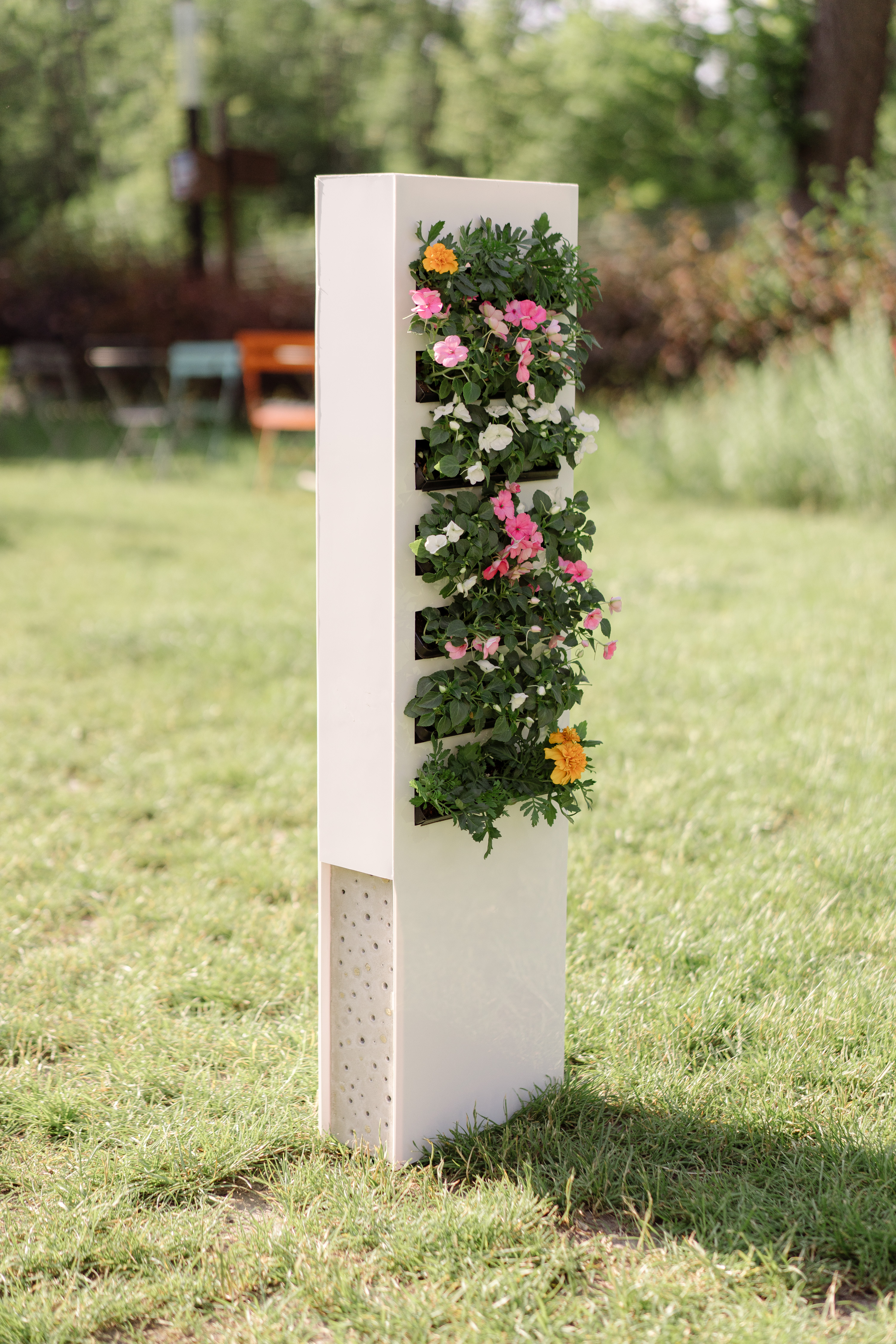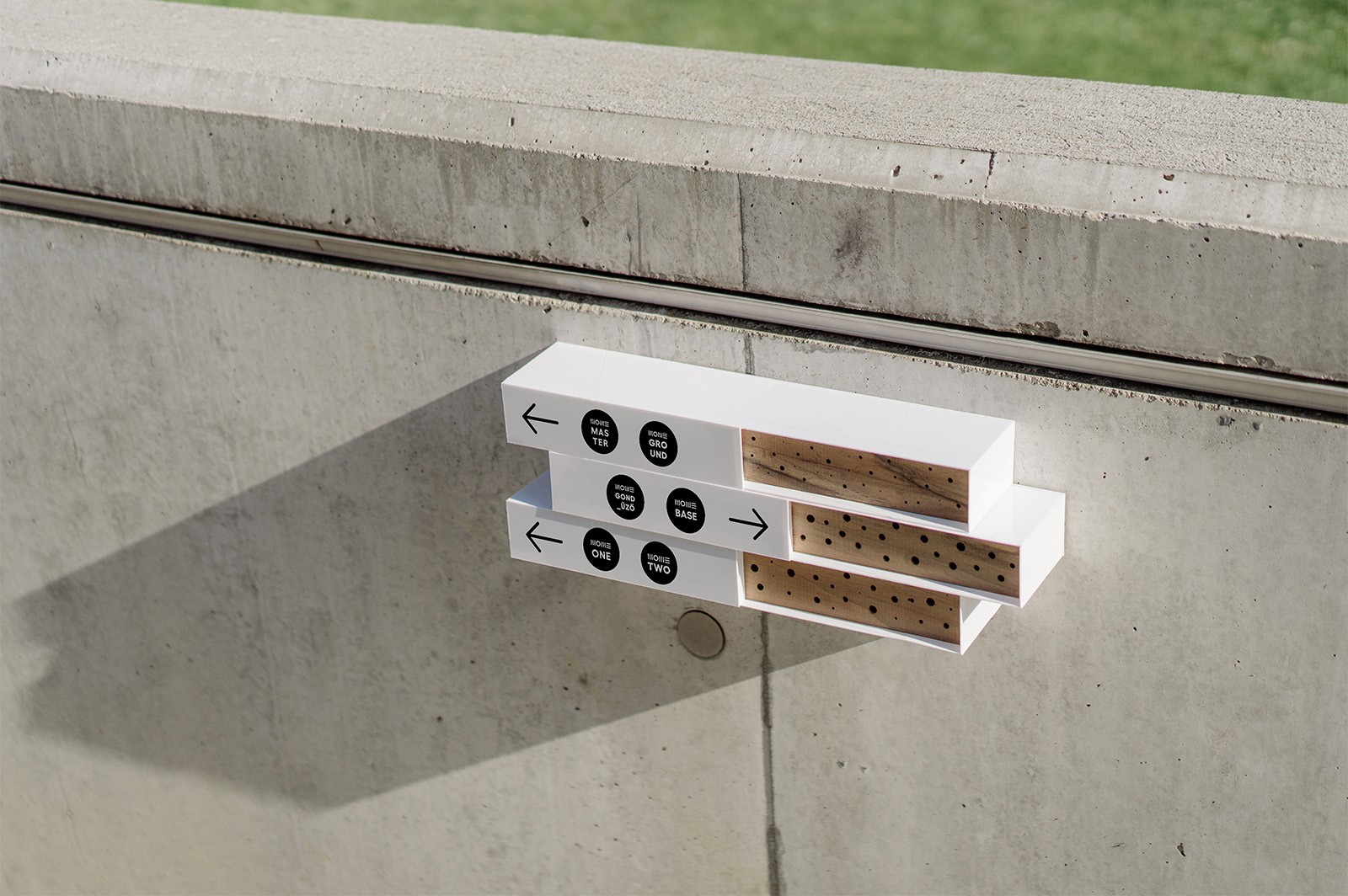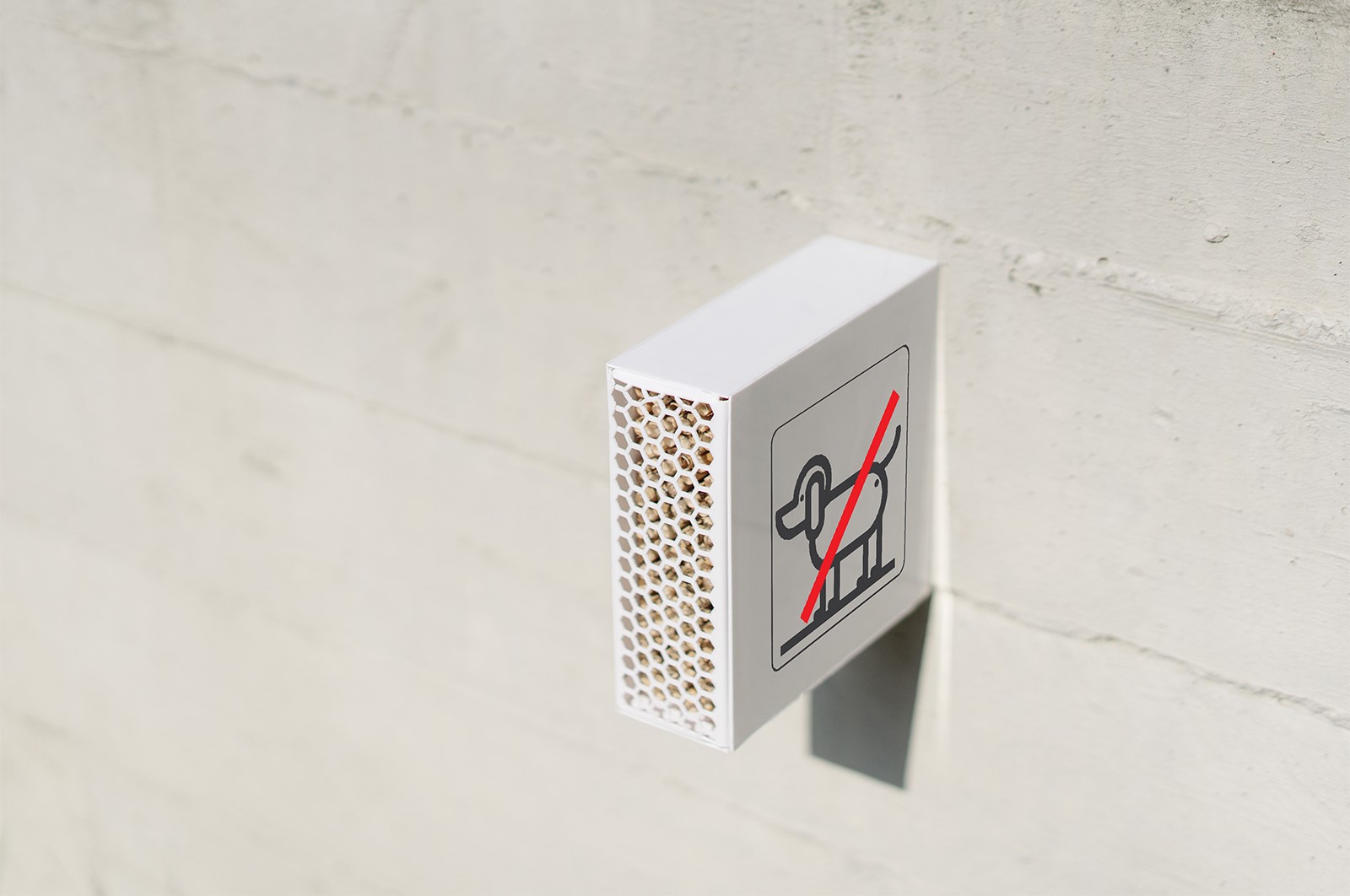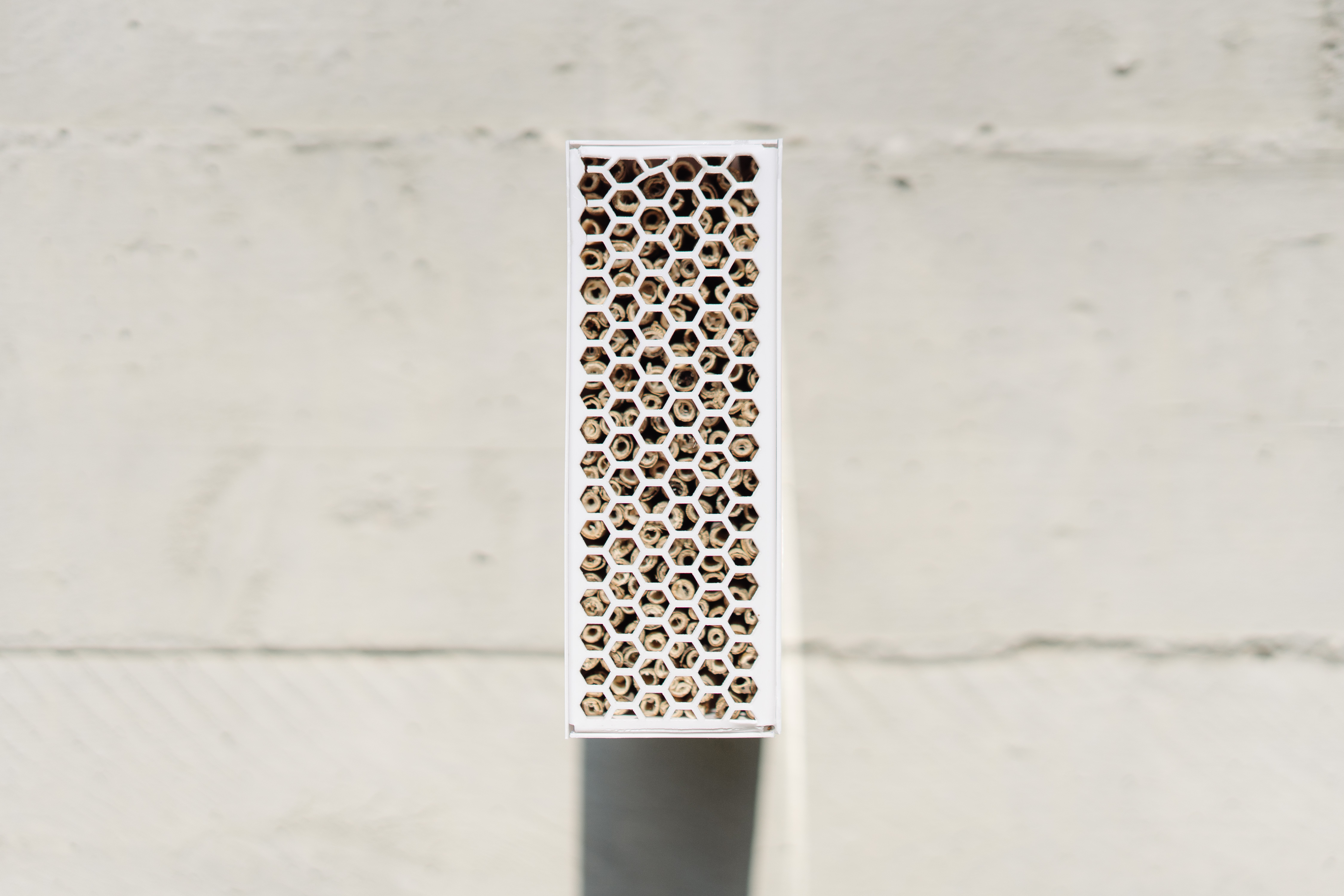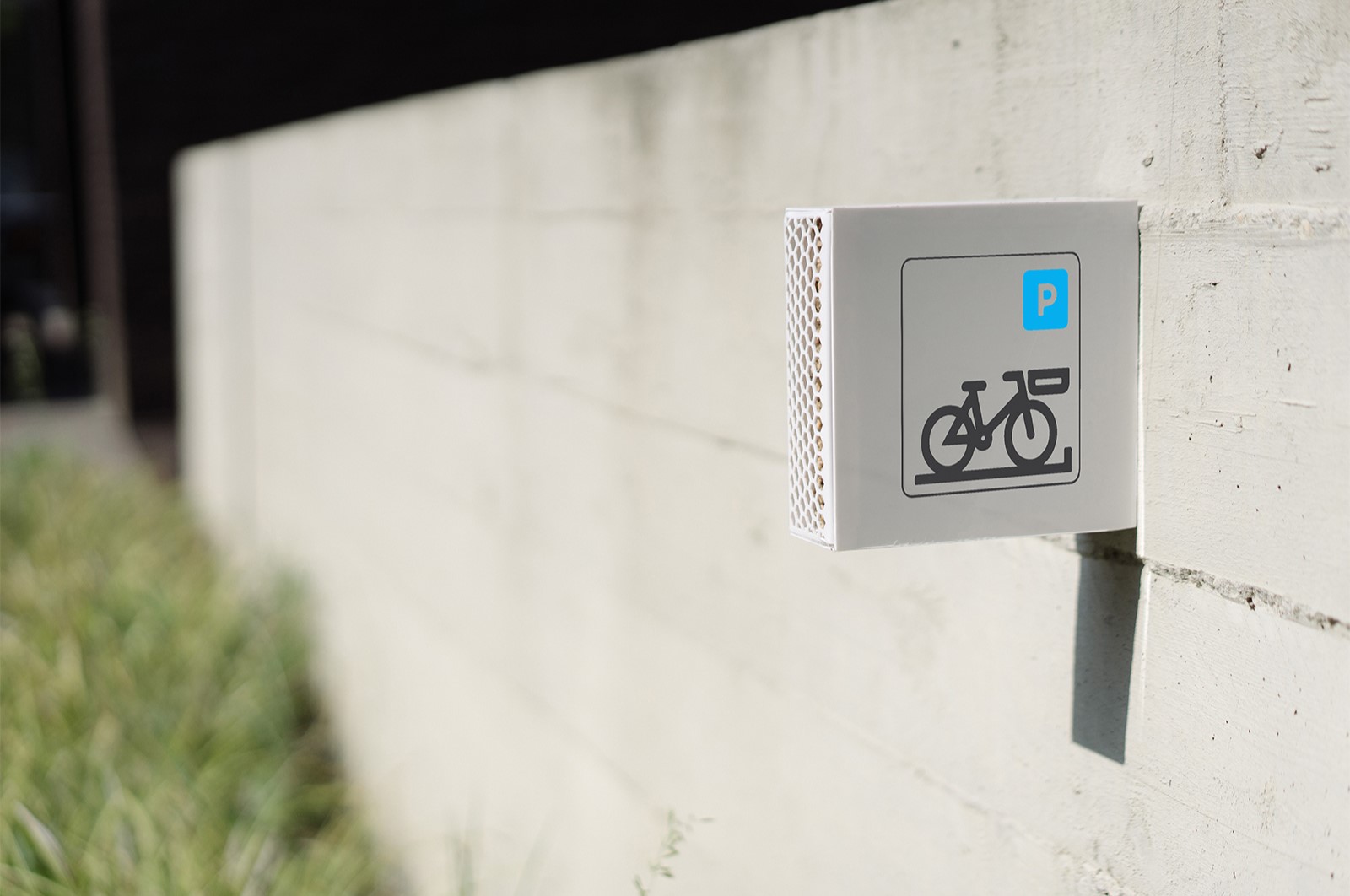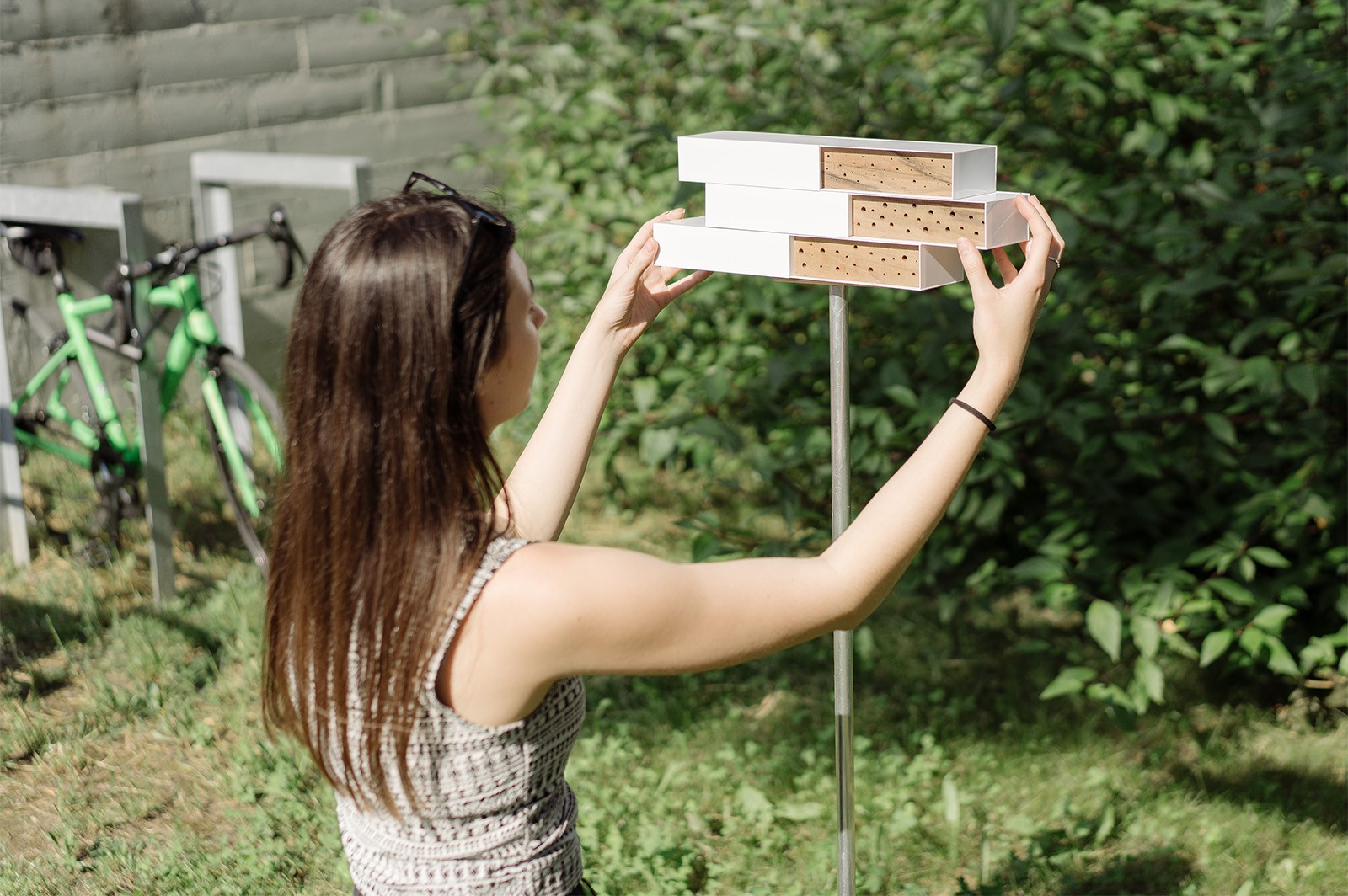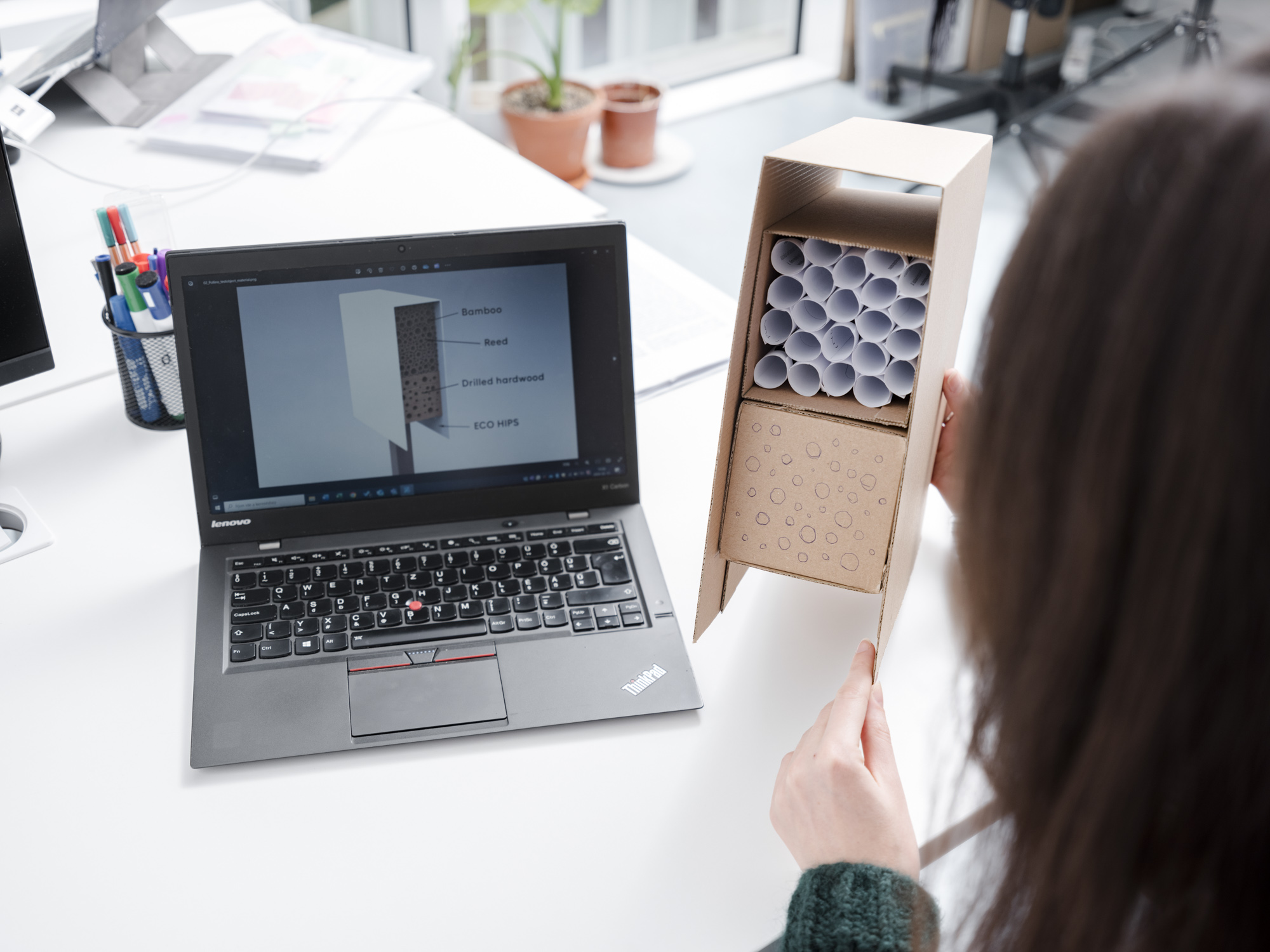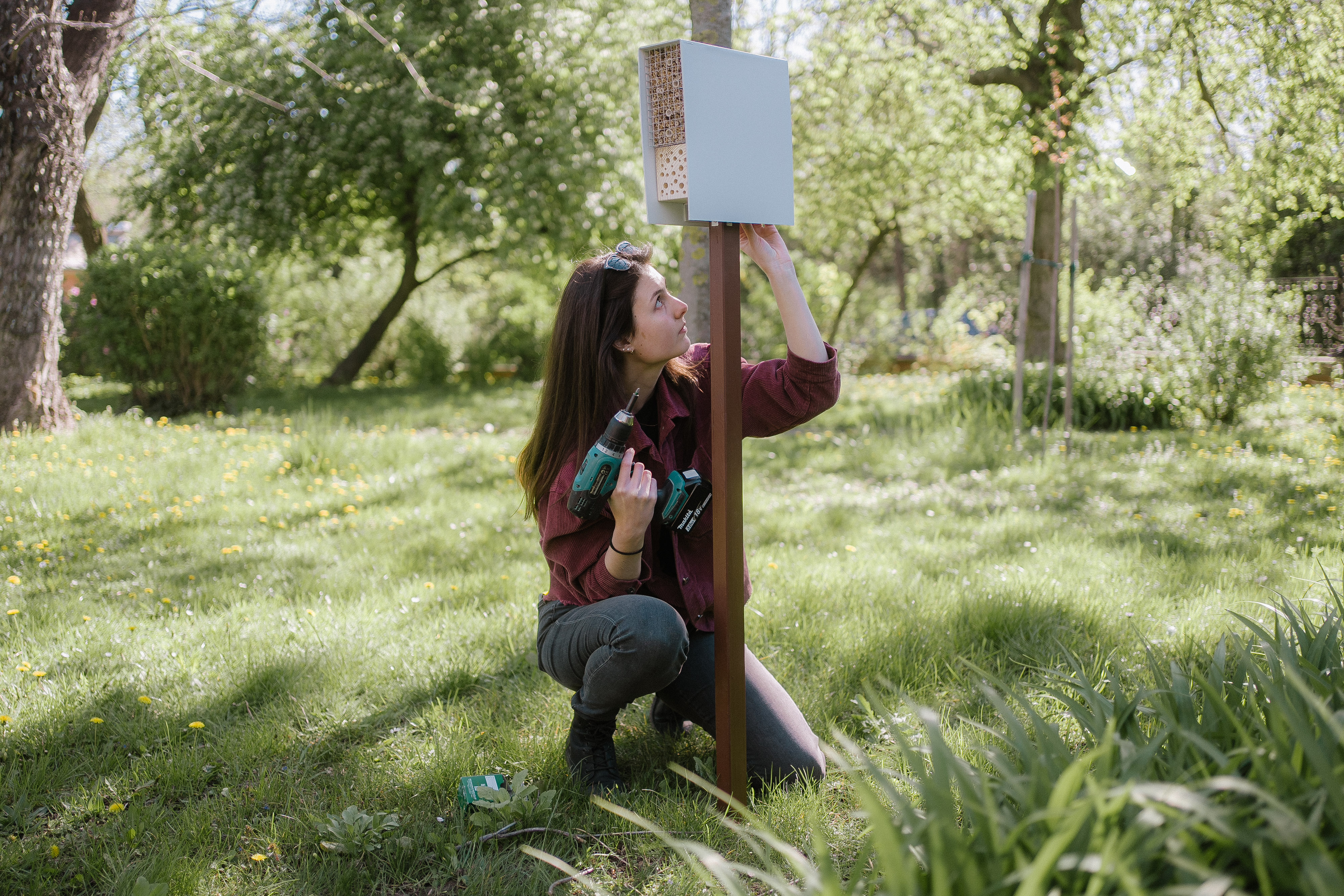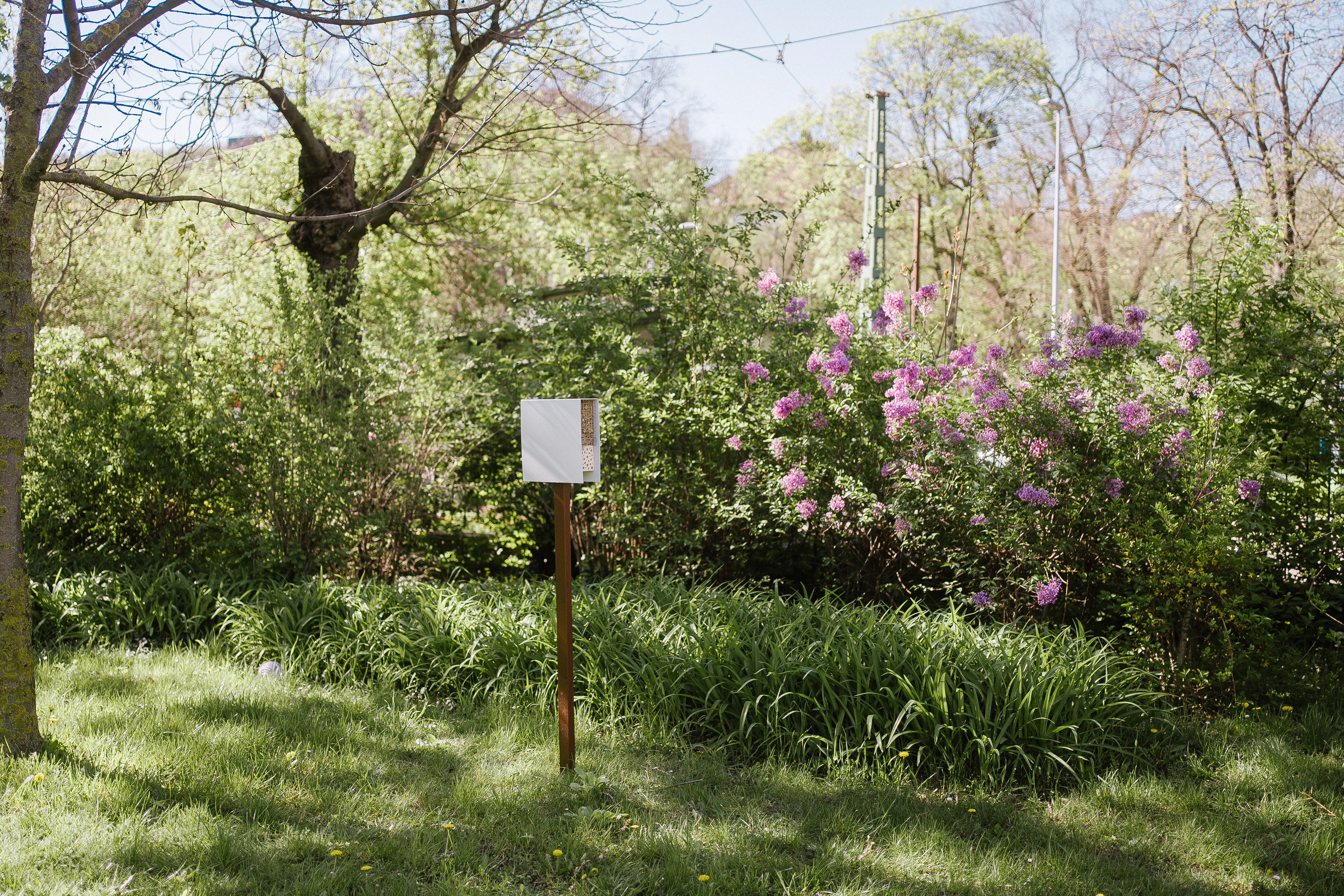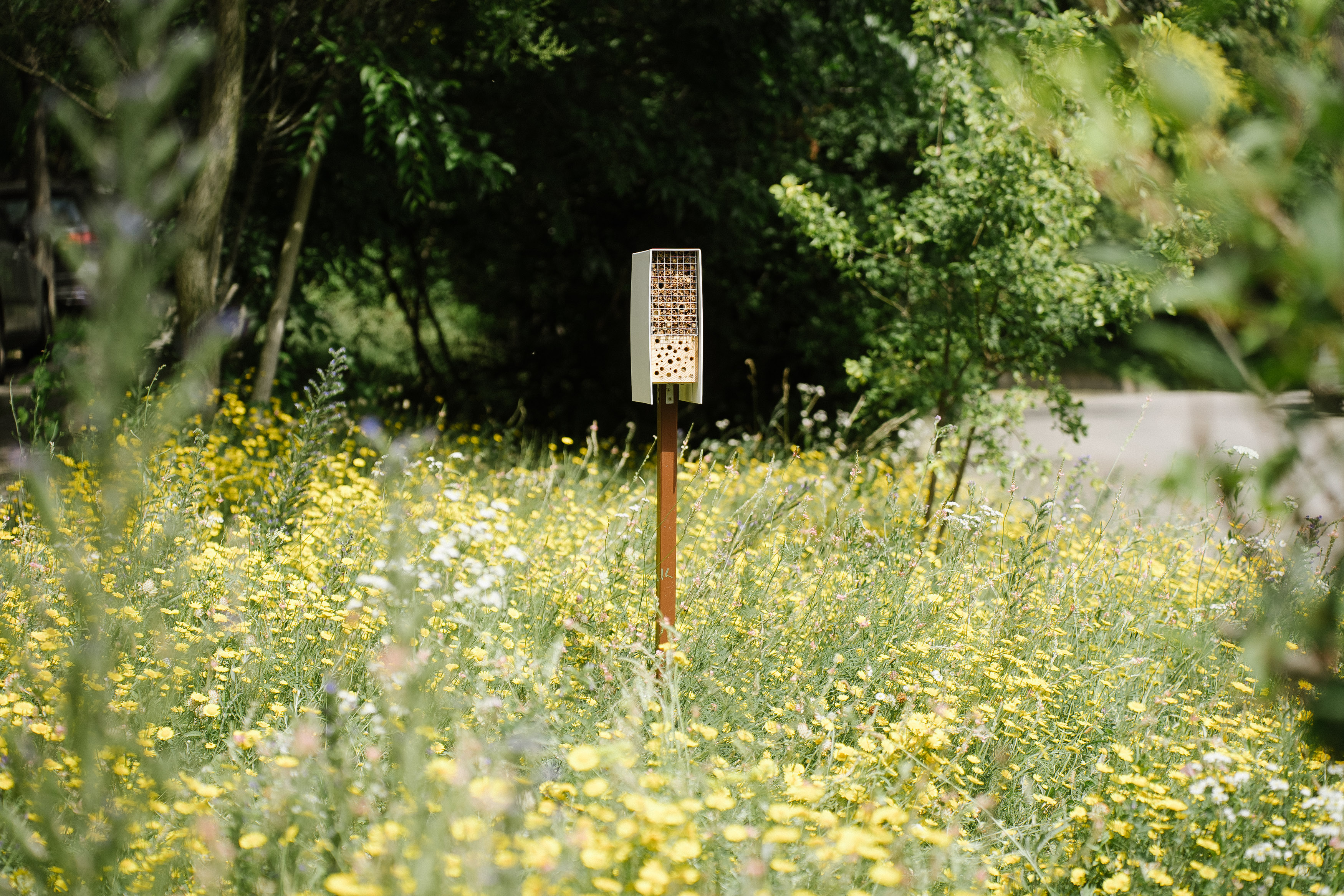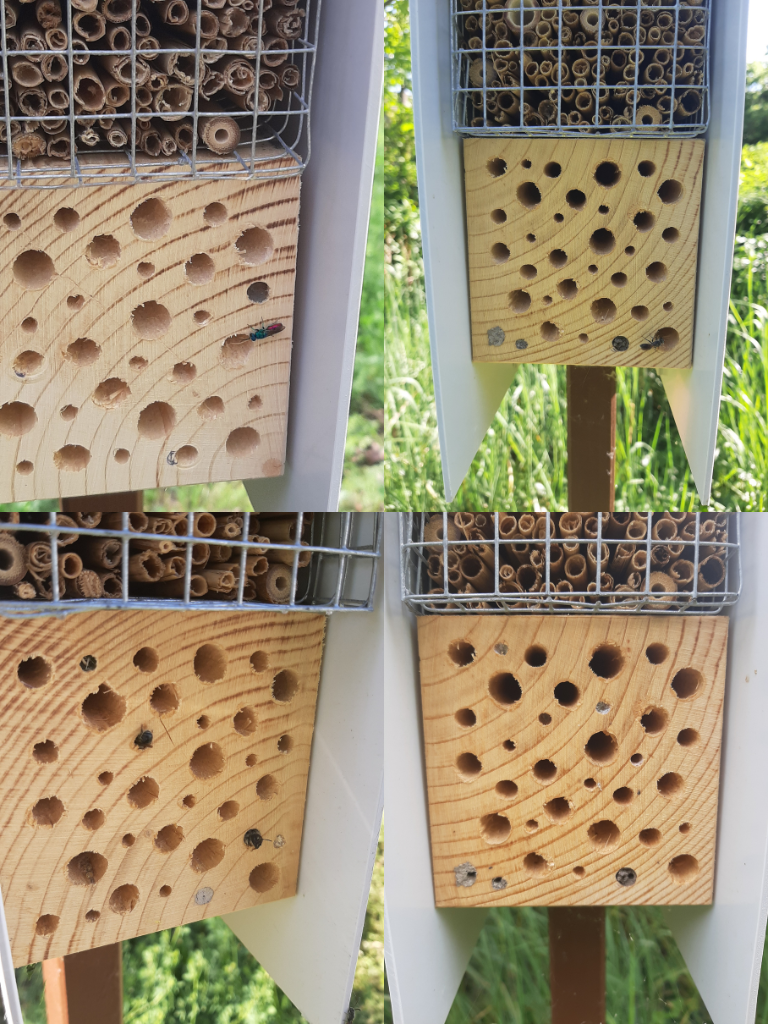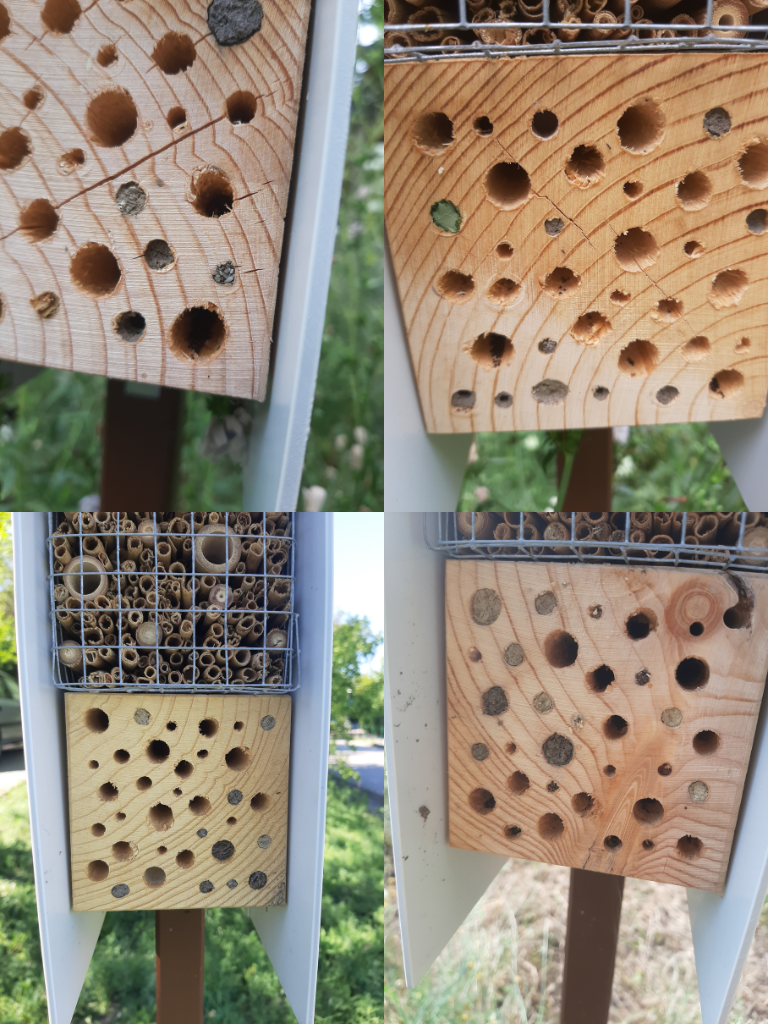Reconnecting with nature
Pollino
Multifunctional wayfinding signage that provides habitat for urban pollinators
Pollino transforms urban signage into multifunctional habitats for wild pollinators, specifically solitary bees, by integrating modular nesting spaces and floral elements. It creates safe nesting spots in cities, helping to connect fragmented ecosystems, support pollinators, and enhance urban aesthetics. Developed through interdisciplinary collaboration, Pollino promotes environmental awareness and resilience, offering a scalable solution for vibrant, sustainable multispecies urban communities.
Hungary
Local
Currently it is implemented and tested in Budapest
Mainly urban
It refers to a physical transformation of the built environment (hard investment)
Prototype level
No
No
As an individual
Pollino is a design concept that transforms urban infrastructure into multifunctional habitats for wild pollinators, focusing on solitary bees. Its overall aim is to combat the urgent decline of pollinator populations - critical agents for plant reproduction, biodiversity, and climate resilience - by reconnecting fragmented ecosystems.
Pollino targets two key groups: wild pollinators, essential for maintaining food security and urban biodiversity, and urban residents, who benefit from enhanced green infrastructure and increased environmental awareness.
The project’s specific objectives are threefold: (1) expanding and connecting isolated pollinator habitats by embedding modular nesting spaces into urban signage to support pollinator mobility and long-term population viability; (2) optimizing limited urban space through multifunctional design that also serves as an informational tool for city dwellers; (3) fostering public engagement by making urban biodiversity visible and accessible, thus nurturing a deeper connection between people and nature.
Developed through interdisciplinary collaboration with ecologists, urban planners, and decision-makers, Pollino was pilot-tested in Budapest with 12 prototype installations deployed and monitored over a year. These pilots provided valuable insights into how material choices, cavity dimensions, and surrounding vegetation influence pollinator occupancy, shaping the design and defining ideal deployment sites. By bridging ecological research and urban design, Pollino exemplifies an innovative, scalable solution that contributes to resilient, multispecies urban ecosystems. With foundational groundwork complete, its current stage as a validated proof-of-concept not only demonstrates immediate ecological benefits but also offers significant potential for widespread implementation.
Pollino targets two key groups: wild pollinators, essential for maintaining food security and urban biodiversity, and urban residents, who benefit from enhanced green infrastructure and increased environmental awareness.
The project’s specific objectives are threefold: (1) expanding and connecting isolated pollinator habitats by embedding modular nesting spaces into urban signage to support pollinator mobility and long-term population viability; (2) optimizing limited urban space through multifunctional design that also serves as an informational tool for city dwellers; (3) fostering public engagement by making urban biodiversity visible and accessible, thus nurturing a deeper connection between people and nature.
Developed through interdisciplinary collaboration with ecologists, urban planners, and decision-makers, Pollino was pilot-tested in Budapest with 12 prototype installations deployed and monitored over a year. These pilots provided valuable insights into how material choices, cavity dimensions, and surrounding vegetation influence pollinator occupancy, shaping the design and defining ideal deployment sites. By bridging ecological research and urban design, Pollino exemplifies an innovative, scalable solution that contributes to resilient, multispecies urban ecosystems. With foundational groundwork complete, its current stage as a validated proof-of-concept not only demonstrates immediate ecological benefits but also offers significant potential for widespread implementation.
More-than-human placemaking
Multispecies cohabitation
Urban biodiversity
Pollinator conservation
Multifunctional design
Pollino addresses a critical sustainability challenge: the rapid decline of wild pollinators, especially solitary bees, which are indispensable for food production, as about 75% of the world’s most productive crops rely on animal pollination. Beyond food security, pollinators enhance climate resilience by fostering cross-pollination, which increases genetic diversity and bolsters plant adaptability against environmental stressors. Alarmingly, their population and biological diversity are declining due to habitat loss, climate change, pesticide use, and disease.
Although cities are often viewed as human-centered environments that challenge ecosystems, they can also offer vital refuges for pollinators, especially as surrounding rural areas may face even greater ecological threats from agricultural intensification and habitat fragmentation. Urban settings frequently provide milder winter temperatures, diverse foraging grounds, and unique microhabitats, though modern maintenance practices can inadvertently reduce natural nesting spaces.
Pollino tackles this ecological urgency by integrating modular nesting spaces and floral elements into urban infrastructure, potentially creating continuous ecological corridors and transforming underutilized urban areas into more-than-human habitats. Iterative prototyping, guided by expert feedback, ensured that key design parameters - such as optimal cavity depth to prevent distorted gender ratios - were optimized.
A pilot deployment of 12 prototypes across Budapest has demonstrated that these installations effectively attract and sustain pollinators even in challenging urban contexts. Moreover, Pollino aims to minimize resource use by multifunctionality and repurposing existing urban assets. By merging ecological functionality with public communication, the project not only supports pollinator survival but also raises environmental awareness among urban residents.
Although cities are often viewed as human-centered environments that challenge ecosystems, they can also offer vital refuges for pollinators, especially as surrounding rural areas may face even greater ecological threats from agricultural intensification and habitat fragmentation. Urban settings frequently provide milder winter temperatures, diverse foraging grounds, and unique microhabitats, though modern maintenance practices can inadvertently reduce natural nesting spaces.
Pollino tackles this ecological urgency by integrating modular nesting spaces and floral elements into urban infrastructure, potentially creating continuous ecological corridors and transforming underutilized urban areas into more-than-human habitats. Iterative prototyping, guided by expert feedback, ensured that key design parameters - such as optimal cavity depth to prevent distorted gender ratios - were optimized.
A pilot deployment of 12 prototypes across Budapest has demonstrated that these installations effectively attract and sustain pollinators even in challenging urban contexts. Moreover, Pollino aims to minimize resource use by multifunctionality and repurposing existing urban assets. By merging ecological functionality with public communication, the project not only supports pollinator survival but also raises environmental awareness among urban residents.
Pollino redefines urban aesthetics by transforming ordinary wayfinding signage into visually engaging, multifunctional installations that enhance the quality of urban experience. The project’s design seamlessly combines ecological functionality with a high standard of visual appeal, fostering an environment where design, nature, and information coalesce to enrich daily life. Employing the concept of “designing for noticing”, Pollino encourages residents to engage with their surroundings, sparking curiosity and dialogue about urban biodiversity.
High-quality materials, refined forms, and adaptable configurations allow Pollino to be tailored to diverse urban settings, whether in public parks, corporate campuses, or historical neighborhoods. This is exemplified by the design concept created for the campus of the Moholy-Nagy University of Art and Design Budapest. The forms, colors and graphics of these signages closely follow the visual identity of the university, making Pollino an integral part of the campus. This customization creates a dynamic dialogue between built structures and natural elements, making the intervention sensitive to local context and cultural heritage.
During pilot deployments in Budapest’s 12th district, the installations sparked curiosity among residents and passersby, drawing attention to the importance of urban biodiversity. Observers noted that the visual contrast between the sleek, modern signage and the natural nesting features inspired conversations about the value of nature in urban environments. This blend of practicality and beauty not only enriches the public realm but also serves as a tool for environmental education, turning everyday encounters into moments of discovery and reflection.
High-quality materials, refined forms, and adaptable configurations allow Pollino to be tailored to diverse urban settings, whether in public parks, corporate campuses, or historical neighborhoods. This is exemplified by the design concept created for the campus of the Moholy-Nagy University of Art and Design Budapest. The forms, colors and graphics of these signages closely follow the visual identity of the university, making Pollino an integral part of the campus. This customization creates a dynamic dialogue between built structures and natural elements, making the intervention sensitive to local context and cultural heritage.
During pilot deployments in Budapest’s 12th district, the installations sparked curiosity among residents and passersby, drawing attention to the importance of urban biodiversity. Observers noted that the visual contrast between the sleek, modern signage and the natural nesting features inspired conversations about the value of nature in urban environments. This blend of practicality and beauty not only enriches the public realm but also serves as a tool for environmental education, turning everyday encounters into moments of discovery and reflection.
Pollino embraces inclusion by designing interventions that benefit both human and non-human inhabitants and highlights the critical importance of including non-humans in urban planning - a practice that is still largely underexplored. Its inclusion objectives are to make urban biodiversity accessible, affordable, and engaging, fostering shared stewardship and empowering communities to actively participate in urban ecological regeneration.
The project employs a flexible, modular design that adapts to diverse contexts, ensuring its ecological benefits reach communities regardless of economic or cultural differences. Pollino’s design prioritizes simplicity and clarity, offering a non-intrusive, aesthetically appealing interface that communicates ecological information to a broad audience. Its straightforward, user-friendly design ensures that individuals of all abilities can easily interact with and appreciate the design.
Pollino’s development was driven by extensive participatory methods, including semi-structured interviews with ecologists, urban planners, and municipal decision-makers. These interactions helped integrate diverse perspectives into the design process, resulting in a solution that is both scientifically robust and socially relevant. Informal conversations with local residents during the pilot phase confirmed that the installations spark curiosity and naturally promote dialogue about urban biodiversity.
In summary, Pollino exemplifies design-for-all principles by creating inclusive, engaging spaces that support wild pollinators while inviting community interaction. By bridging ecological functionality with social engagement, Pollino not only enhances urban resilience and biodiversity but also paves the way for innovative, inclusive governance models that involve citizens in the stewardship of their environment. Future enhancements will further deepen citizen participation, ensuring the project’s long-term, replicable impact in diverse settings.
The project employs a flexible, modular design that adapts to diverse contexts, ensuring its ecological benefits reach communities regardless of economic or cultural differences. Pollino’s design prioritizes simplicity and clarity, offering a non-intrusive, aesthetically appealing interface that communicates ecological information to a broad audience. Its straightforward, user-friendly design ensures that individuals of all abilities can easily interact with and appreciate the design.
Pollino’s development was driven by extensive participatory methods, including semi-structured interviews with ecologists, urban planners, and municipal decision-makers. These interactions helped integrate diverse perspectives into the design process, resulting in a solution that is both scientifically robust and socially relevant. Informal conversations with local residents during the pilot phase confirmed that the installations spark curiosity and naturally promote dialogue about urban biodiversity.
In summary, Pollino exemplifies design-for-all principles by creating inclusive, engaging spaces that support wild pollinators while inviting community interaction. By bridging ecological functionality with social engagement, Pollino not only enhances urban resilience and biodiversity but also paves the way for innovative, inclusive governance models that involve citizens in the stewardship of their environment. Future enhancements will further deepen citizen participation, ensuring the project’s long-term, replicable impact in diverse settings.
Pollino’s deployment in Budapest’s 12th district sparked an organic, community-driven dialogue about pollinators and urban biodivesity. Through informal encounters during regular site visits, residents expressed curiosity and shared their enthusiasm over the visually appealing design and novel concept of integrating ecological functions into everyday urban elements. Many revealed that pollinators, particularly solitary bees, were largely unknown to them and they often confused them with wasps or assumed that they primarily lived in rural environments away from cities. These interactions revealed an important area for public education and knowledge dissemination. While no formal workshops were conducted, Pollino’s pilot installations created an accessible platform for learning about urban biodiversity. Local residents and passersby asked insightful questions about how the installations worked, the role and lifestyle of various bee species, and how they could contribute to pollinator conservation or build bee-friendly environments in their own homes.
With each installation, Pollino offered residents an immediate connection to nature – one that is not only educational but practical. Through these engagements, the project also proved its potential as an educational tool targeting a broad, diverse audience. For example, questions about bee pastures shed light on the misperceptions people had, opening the door for future participatory initiatives centered on effective community education. Despite a minor incidence of vandalism (graffiti marker) on one of the deployed objects, the public reaction was overall positive and encouraging.
Pollino exemplifies how urban interventions can serve as bridges to reconnect people with nature, improving quality of life, fostering an understanding of ecological issues and sparking active participation in solutions.
With each installation, Pollino offered residents an immediate connection to nature – one that is not only educational but practical. Through these engagements, the project also proved its potential as an educational tool targeting a broad, diverse audience. For example, questions about bee pastures shed light on the misperceptions people had, opening the door for future participatory initiatives centered on effective community education. Despite a minor incidence of vandalism (graffiti marker) on one of the deployed objects, the public reaction was overall positive and encouraging.
Pollino exemplifies how urban interventions can serve as bridges to reconnect people with nature, improving quality of life, fostering an understanding of ecological issues and sparking active participation in solutions.
Pollino’s design and implementation was shaped by active engagement across local, regional, and national levels, ensuring that the project not only meets ecological goals but also resonates with urban communities and institutional priorities.
At the local level, I conducted interviews and collaborated with municipal decision-makers, including representatives from a Green Office, who provided essential guidance on urban space constraints, accessibility, visibility, and sustainability. This collaboration was vital for site selection, navigating regulatory requirements, and fostering strong relationships with other city entities, including urban planning departments, park maintenance, and police. Their support in facilitating deployment and gaining necessary permits further strengthened the project as part of the city’s ecological strategy.
Regionally, collaborators from urban park maintenance authorities shared their experiences with similar interventions, highlighting practical challenges and public perceptions, which further refined the project’s operational strategy. Their on-the-ground expertise contributed critical feedback on maintenance, durability, and design optimization, ensuring long-term functionality of Pollino. An interview with an urban planner and landscape architect provided valuable input on ecological best practices and urban design integration. Their ongoing support and feedback ensured that Pollino is adaptable, cost-effective and scalable within regional municipalities’ budgetary and ecological frameworks.
Nationally, interviews with experts from a renowned Ecological Research Centre contributed critical data and scientific validation. The insights of this multidisciplinary dialogue directly influenced design parameters and ongoing consultation throughout the project informed iterative design decisions. They played a central role in designing the monitoring system, determining which parameters to track and establishing data collection methods.
At the local level, I conducted interviews and collaborated with municipal decision-makers, including representatives from a Green Office, who provided essential guidance on urban space constraints, accessibility, visibility, and sustainability. This collaboration was vital for site selection, navigating regulatory requirements, and fostering strong relationships with other city entities, including urban planning departments, park maintenance, and police. Their support in facilitating deployment and gaining necessary permits further strengthened the project as part of the city’s ecological strategy.
Regionally, collaborators from urban park maintenance authorities shared their experiences with similar interventions, highlighting practical challenges and public perceptions, which further refined the project’s operational strategy. Their on-the-ground expertise contributed critical feedback on maintenance, durability, and design optimization, ensuring long-term functionality of Pollino. An interview with an urban planner and landscape architect provided valuable input on ecological best practices and urban design integration. Their ongoing support and feedback ensured that Pollino is adaptable, cost-effective and scalable within regional municipalities’ budgetary and ecological frameworks.
Nationally, interviews with experts from a renowned Ecological Research Centre contributed critical data and scientific validation. The insights of this multidisciplinary dialogue directly influenced design parameters and ongoing consultation throughout the project informed iterative design decisions. They played a central role in designing the monitoring system, determining which parameters to track and establishing data collection methods.
Pollino’s design and implementation were driven by an interdisciplinary Research-through-Design approach that brought together ecology, urban planning, municipal governance, manufacturing, and design. As the central coordinator, I facilitated semi-structured interviews and collaborative sessions with ecologists who provided ongoing feedback and critical insights on pollinator behavior and habitat requirements, such as optimal nesting cavity dimensions to ensure reproductive success, thereby guiding material selection and spatial configuration.
Simultaneously, urban planners and municipal decision-makers from the local Green Office guided site selection and addressed practical constraints, helping secure necessary permissions and refining the project’s integration into the urban fabric, enhancing public utility. A chief landscape architect contributed valuable perspectives on designing low-maintenance, durable interventions, emphasizing the need for solutions that can thrive under urban conditions.
My design practice was further enriched through consultations with fellow designers and academic mentors who critiqued and enhanced both the conceptual and physical aspects of Pollino. The manufacturing phase in a dedicated modeling and woodworking workshop provided technical expertise, as workshop leaders offered practical advice on prototype fabrication. This iterative process allowed for continuous integration of feedback from all disciplines, effectively balancing scientific rigor with practical and aesthetic considerations.
Overall, this collaborative process not only validated Pollino’s ecological functionality but also enhanced its relevance as a sustainable urban intervention. It exemplifies the essential role of designers as mediators who translate complex, interdisciplinary knowledge into tangible, impactful solutions for urban biodiversity challenges.
Simultaneously, urban planners and municipal decision-makers from the local Green Office guided site selection and addressed practical constraints, helping secure necessary permissions and refining the project’s integration into the urban fabric, enhancing public utility. A chief landscape architect contributed valuable perspectives on designing low-maintenance, durable interventions, emphasizing the need for solutions that can thrive under urban conditions.
My design practice was further enriched through consultations with fellow designers and academic mentors who critiqued and enhanced both the conceptual and physical aspects of Pollino. The manufacturing phase in a dedicated modeling and woodworking workshop provided technical expertise, as workshop leaders offered practical advice on prototype fabrication. This iterative process allowed for continuous integration of feedback from all disciplines, effectively balancing scientific rigor with practical and aesthetic considerations.
Overall, this collaborative process not only validated Pollino’s ecological functionality but also enhanced its relevance as a sustainable urban intervention. It exemplifies the essential role of designers as mediators who translate complex, interdisciplinary knowledge into tangible, impactful solutions for urban biodiversity challenges.
Pollino stands out in the field of sustainable urban design through its innovative integration of ecological functionality with urban infrastructure. Rather than isolating ecological concerns, Pollino embeds habitats directly into wayfinding signage, transforming ordinary infrastructure into vibrant ecological networks, serving both human and non-human residents. The project’s innovation lies in its dual functionality, contributing to creating ecological corridors in dense urban environments, enabling pollinator mobility and enhancing overall biodiversity.
A key strength of Pollino is its highly modular and customizable design, which adapts to various urban contexts from dense metropolitan areas or quieter suburbs. Its development involved a participatory, interdisciplinary approach, engaging ecologists, urban planners and municipal decision-makers to ensure that both ecological and social dimensions are effectively integrated into the project. This collaboration informed design decisions, such as optimized cavity dimensions for pollinator nesting, based on rigorous scientific insights from ecological research. Pollino has been iteratively refined to address real-world constraints such as limited urban space and the need for low-maintenance solutions.
Pilot testing has validated key design parameters, demonstrating that the installations attract and sustain pollinator activity even under urban constraints. This evidence-based approach underscores Pollino’s ecological effectiveness and public appeal, laying a solid foundation for widespread implementation.
By merging ecological considerations with public communication, Pollino redefines how cities can integrate nature into the urban fabric in innovative ways, paving the way for a future where humans and pollinators coexist symbiotically. The project’s potential to scale and replicate in cities worldwide sets a precedent for integrating sustainability into the heart of urban life.
A key strength of Pollino is its highly modular and customizable design, which adapts to various urban contexts from dense metropolitan areas or quieter suburbs. Its development involved a participatory, interdisciplinary approach, engaging ecologists, urban planners and municipal decision-makers to ensure that both ecological and social dimensions are effectively integrated into the project. This collaboration informed design decisions, such as optimized cavity dimensions for pollinator nesting, based on rigorous scientific insights from ecological research. Pollino has been iteratively refined to address real-world constraints such as limited urban space and the need for low-maintenance solutions.
Pilot testing has validated key design parameters, demonstrating that the installations attract and sustain pollinator activity even under urban constraints. This evidence-based approach underscores Pollino’s ecological effectiveness and public appeal, laying a solid foundation for widespread implementation.
By merging ecological considerations with public communication, Pollino redefines how cities can integrate nature into the urban fabric in innovative ways, paving the way for a future where humans and pollinators coexist symbiotically. The project’s potential to scale and replicate in cities worldwide sets a precedent for integrating sustainability into the heart of urban life.
Pollino began as a design diploma project, where the concept was born through a deep research phase and iterative design process. Focusing on solitary bees, research explored their needs and challenges in urban environments. Semi-structured interviews with stakeholders (landscape architects, urban planners, decisionmakers) provided valuable insights into the role of urban design in supporting biodiversity. These conversations, combined with collaboration with ecological experts, shaped Pollino’s eventual design. A key part of the methodology was to create a proof-of-concept project, to illustrate how the design would look in real life. I applied the concept to the university campus of MOME, integrating both ecological and informational perspectives into the design (I did a campus analysis, studying the variety of plants, human flow, and informational needs). Based on these insights, the product family I designed for the campus consisted of 3 types of signs: large standing signs, wayfinding signs and place marker signs. I manufactured the prototypes of these signs and temporarily exhibited them at the university to gather feedback
Moving beyond the academic setting, I planned a real-world test to evaluate the system’s effectiveness and adaptability across different environments. In collaboration with the local municipality, I deployed 12 pilot objects across various locations: heavily urbanized areas, public parks, and wildflower patches to allow comparative analysis. I designed a monitoring system in collaboration with ecologists to collect data on occupancy, surrounding vegetation and insect activity. Through monthly visits to the pilot sites, I collected data for a year that is currently under analysis, with preliminary findings underscoring the importance of habitat quality and helping identify ideal deployment locations. This method provides evidence of Pollino’s viability as an adaptable, scalable solution and demonstrates its potential for widespread adoption
Moving beyond the academic setting, I planned a real-world test to evaluate the system’s effectiveness and adaptability across different environments. In collaboration with the local municipality, I deployed 12 pilot objects across various locations: heavily urbanized areas, public parks, and wildflower patches to allow comparative analysis. I designed a monitoring system in collaboration with ecologists to collect data on occupancy, surrounding vegetation and insect activity. Through monthly visits to the pilot sites, I collected data for a year that is currently under analysis, with preliminary findings underscoring the importance of habitat quality and helping identify ideal deployment locations. This method provides evidence of Pollino’s viability as an adaptable, scalable solution and demonstrates its potential for widespread adoption
-Customizable Design: Pollino was intentionally designed to be replicable across diverse contexts. Its flexible design system allows for tailoring the number and visual of the signs to local conditions. The design can be easily adjusted in terms of size, configuration, and aesthetics aligning with the cultural or brand identity of deployment locations
-Multifunctionality: The notion of integrating ecological functions into everyday infrastructure can be replicated to maximize limited urban space and serve humans and non-humans alike
-Research-driven Approach: Pollino’s research-through-design methodology, which combines ecological assessment, stakeholder interviews, and iterative prototyping, creates a replicable framework. The ecological monitoring and stakeholder engagement during the pilot deployment provides critical data on how similar interventions might work in other cities or neighborhoods
-Monitoring and Evaluation System: The structured monitoring system employed during the pilot phase provides a model for evaluating the effectiveness of other Pollino implementations. It has generated valuable data on occupancy, insect behavior, environmental factors and habitat effectiveness, enabling real-time evaluation and iterative improvement, as well as defining deployment strategies
-Collaborative Framework: Pollino’s collaborative approach, involving ecologists, municipal authorities, and local stakeholders, has been central to the success of the project. This participatory process, driven by interdisciplinary expertise and local engagement, can be replicated in other cities to ensure that each implementation aligns with local policy, community dynamics and ecological priorities.
-Scalability Across Species: While Pollino primarily supports solitary bees, its underlying principles are applicable to other urban-dwelling species. The design can be expanded or modified to address a broader spectrum of urban biodiversity challenges, enhancing its overall impact.
-Multifunctionality: The notion of integrating ecological functions into everyday infrastructure can be replicated to maximize limited urban space and serve humans and non-humans alike
-Research-driven Approach: Pollino’s research-through-design methodology, which combines ecological assessment, stakeholder interviews, and iterative prototyping, creates a replicable framework. The ecological monitoring and stakeholder engagement during the pilot deployment provides critical data on how similar interventions might work in other cities or neighborhoods
-Monitoring and Evaluation System: The structured monitoring system employed during the pilot phase provides a model for evaluating the effectiveness of other Pollino implementations. It has generated valuable data on occupancy, insect behavior, environmental factors and habitat effectiveness, enabling real-time evaluation and iterative improvement, as well as defining deployment strategies
-Collaborative Framework: Pollino’s collaborative approach, involving ecologists, municipal authorities, and local stakeholders, has been central to the success of the project. This participatory process, driven by interdisciplinary expertise and local engagement, can be replicated in other cities to ensure that each implementation aligns with local policy, community dynamics and ecological priorities.
-Scalability Across Species: While Pollino primarily supports solitary bees, its underlying principles are applicable to other urban-dwelling species. The design can be expanded or modified to address a broader spectrum of urban biodiversity challenges, enhancing its overall impact.
Pollino addressed multiple pressing global challenges by providing localized, tangible, actionable solutions within urban ecosystems. It targets the rapid decline of pollinator populations, particularly solitary bees, biodiversity loss, habitat fragmentation, and the urgent need for sustainable urban development.
Pollinators are indispensable yet often undervalued contributors to global ecosystems. They underpin biodiversity, climate resilience, human nutrition, and global food security, with approximately 75% of the world’s most productive crops relying on animal pollination. Beyond food production, pollinators enhance climate resilience by fostering cross-pollination, increasing genetic diversity and bolstering plant adaptability against environmental stressors.
Over recent decades, the population and biological diversity of wild pollinators have been alarmingly declining due to habitat loss, climate change, pesticide use, and disease, leaving ecosystems increasingly vulnerable. Pollinators are increasingly forced to navigate shifting temperatures, changing floral resources, and altered flowering patterns. As environmental conditions shift, they must adapt or migrate to survive, making habitat connectivity and expansion critical for their persistence.
Urban areas, traditionally seen as threats due to modern building practices that reduce natural nesting spaces, also offer unique opportunities for pollinators. Milder winter temperatures, diverse microhabitats, and potential for adaptive green infrastructure can favor pollinator survival if properly harnessed. Pollino transforms conventional urban signage into multifunctional habitats that reconnect fragmented green spaces. In doing so, it supports pollinator populations and helps restore humanity’s lost relationship with nature, ultimately enhancing urban quality of life and promoting both physical and mental well-being, while also raising awareness about pollinators and urban biodiversity in general.
Pollinators are indispensable yet often undervalued contributors to global ecosystems. They underpin biodiversity, climate resilience, human nutrition, and global food security, with approximately 75% of the world’s most productive crops relying on animal pollination. Beyond food production, pollinators enhance climate resilience by fostering cross-pollination, increasing genetic diversity and bolstering plant adaptability against environmental stressors.
Over recent decades, the population and biological diversity of wild pollinators have been alarmingly declining due to habitat loss, climate change, pesticide use, and disease, leaving ecosystems increasingly vulnerable. Pollinators are increasingly forced to navigate shifting temperatures, changing floral resources, and altered flowering patterns. As environmental conditions shift, they must adapt or migrate to survive, making habitat connectivity and expansion critical for their persistence.
Urban areas, traditionally seen as threats due to modern building practices that reduce natural nesting spaces, also offer unique opportunities for pollinators. Milder winter temperatures, diverse microhabitats, and potential for adaptive green infrastructure can favor pollinator survival if properly harnessed. Pollino transforms conventional urban signage into multifunctional habitats that reconnect fragmented green spaces. In doing so, it supports pollinator populations and helps restore humanity’s lost relationship with nature, ultimately enhancing urban quality of life and promoting both physical and mental well-being, while also raising awareness about pollinators and urban biodiversity in general.
Pollino’s next phase builds on its successful 2024 pilot, aiming to scale, customize, and enhance interactivity. The plan is structured around three main goals:
1. Wider Implementation and Monitoring
-Analyze 2024 monitoring data with ecologists; finalize insights by February 2025
-Manufacture new prototypes in January 2025 and deploy them in March 2025, with local authorities facilitating permits
-Conduct species identification by a professional taxonomist (results by August 2025)
-Refine deployment strategies based on correlations between floral proximity and pollinator occupancy
-Explore advanced data collection methods (sensor-based tracking, citizen science initiatives)
2. Customized Concept Development
-Develop a “Pollino Portfolio” that showcases design variants adaptable to different urban contexts, serving as a visual and technical guide for potential partners
-Create an informational package detailing the concept’s benefits, design possibilities, and positive impact
-Engage potential partners (companies, institutions, municipalities) to conduct site-specific analyses, and tailor the design through customized briefs
-Finalize, manufacture, and deploy context-specific prototypes
3. Enhanced Interaction and Communication
-Research-through-Design project initiated to integrate interactive features (QR codes, apps, dynamic infographics)
-Months 1–4: conduct a literature review and plan co-design workshops with residents, ecologists, and designers
-Months 4–10: develop and iterate digital and physical prototypes, refining features based on feedback
-Months 10–12: finalize and implement the interactive designs, potentially launching a citizen science component for real-time monitoring and engagement.
This will transform Pollino from a validated pilot into a robust, scalable intervention that bridges ecological research and urban design, delivering tangible environmental and social benefits and paving the way for widespread adoption.
1. Wider Implementation and Monitoring
-Analyze 2024 monitoring data with ecologists; finalize insights by February 2025
-Manufacture new prototypes in January 2025 and deploy them in March 2025, with local authorities facilitating permits
-Conduct species identification by a professional taxonomist (results by August 2025)
-Refine deployment strategies based on correlations between floral proximity and pollinator occupancy
-Explore advanced data collection methods (sensor-based tracking, citizen science initiatives)
2. Customized Concept Development
-Develop a “Pollino Portfolio” that showcases design variants adaptable to different urban contexts, serving as a visual and technical guide for potential partners
-Create an informational package detailing the concept’s benefits, design possibilities, and positive impact
-Engage potential partners (companies, institutions, municipalities) to conduct site-specific analyses, and tailor the design through customized briefs
-Finalize, manufacture, and deploy context-specific prototypes
3. Enhanced Interaction and Communication
-Research-through-Design project initiated to integrate interactive features (QR codes, apps, dynamic infographics)
-Months 1–4: conduct a literature review and plan co-design workshops with residents, ecologists, and designers
-Months 4–10: develop and iterate digital and physical prototypes, refining features based on feedback
-Months 10–12: finalize and implement the interactive designs, potentially launching a citizen science component for real-time monitoring and engagement.
This will transform Pollino from a validated pilot into a robust, scalable intervention that bridges ecological research and urban design, delivering tangible environmental and social benefits and paving the way for widespread adoption.


